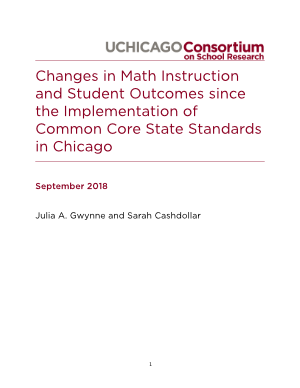1. How has math instruction changed since the implementation of the CCSS-M in 2014-15 in schools with differing levels of standards-related professional development?
2. How have students’ math outcomes, including test scores and grades, changed since implementation of the CCSS-M in 2014-15 in schools with differing levels of standards-related professional development?
This new working paper uses survey responses and student grades and test scores to examine how math instruction and student outcomes have changed in schools with differing levels of CCSS professional development since the implementation of the new Common Core Mathematics standards (CCSS-M) in Chicago Public Schools (CPS) in 2014-15. It found that elementary students and high school students reported increasingly higher average levels of academic demand, rigor, instructional clarity, and also teacher support from the pre-implementation period (2010-11 and 2011-12) to the early implementation period (2014-15, 2015-16, and 2016-17) in schools with limited, average, and extensive professional development. At both the high school and elementary school levels, improvements in instruction were significantly larger in schools with extensive standards-related professional development than in schools with limited professional development; however, patterns of improvement were different for elementary vs. high schools
Among sixth- through eighth-grade students, average math test scores, course grades, and course passing rates also improved over time regardless of the level of standards-related professional development in their schools. Nevertheless, improvements in test scores and math course pass rates were significantly larger for students in schools with extensive standards-related professional development than for students in schools where professional development was limited. At the high-school level, improvements over time in average test scores, math course grades, and pass rates were comparable for students in schools with differing levels of standards-related professional development.
The study also examined whether improvements in math instruction differed for students enrolled in "Deep Support" schools—schools that received additional standards-related support in the form of professional learning communities and coaching—compared to students in schools that did not receive this kind of support. Among sixth- through eighth-grade students, improvements in academic demand and teacher supports were not as large in Deep Support schools as in non-Deep Support schools, although the differences were small. In terms of student outcomes, test scores improved at significantly higher rates for elementary and high school students in Deep Support schools (although the differences were small), but improvements in grades and course pass rates, at least at the elementary level, were not as large in these schools. At the high-school level, improvements in math grades and pass rates were similar in Deep Support and non-Deep-Support schools.


